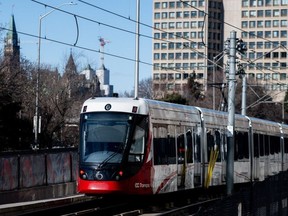“It’s a healthy situation that there is a difference of opinion and there is a genuine attempt to find what the root cause it, what the right solution is and to do that in a collaborative way.”

Article content
Months of testing of Ottawa’s LRT have revealed much about the Confederation Line.
Stresses on the wheels are less when the train is running east on the shallow four-per-cent downhill run from Tunney’s Pasture to Blair station and greater on the westbound uphill run.
Rainy days mean less friction and less stress on the wheels.
Laying down rails of harder steel would ease wear and tear on the tracks, but wouldn’t reduce the high lateral loads that cause wheel assemblies to wear out and fail prematurely.
Advertisement 2
Story continues below
Article content
But, despite all the testing, the cause of — and a solution for — the LRT’s wheel woes remains stubbornly elusive. And the city, Rideau Transit Group — the consortium that built the LRT — and trainmaker Alstom remain at loggerheads about how to fix it.
“It is frustrating that we’re here, years later, and still without a root cause, still without a definitive answer,” said Coun. Glen Gower, who chaired a lengthy joint meeting of the transit commission and light-rail sub-committee on Friday. “Hopefully we’ll have it soon, but we can’t move the timeline on any of this.”
The public briefing followed a two-hour in camera session. In all, councillors listened to six hours of presentations from legal staff, transit general manager Renée Amilcar, city director of engineering services Richard Holder and Nicolas Truchon, CEO of RTG, about efforts to fix the trains’ troublesome cartridge bearing assemblies.
Failures of the assemblies, either a full-on fracture or simply loosening until they are outside the allowable tolerances, have led to three lengthy shutdowns of the line, including an August 2021 derailment near Tunney’s Pasture Station.
Advertisement 3
Story continues below
Article content
“It’s frustrating to councillors that we’re trying to exercise oversight, but we can’t demonstrate that to the public because so much of this is in camera or protected by confidentiality,” Gower said.
“I hope people aren’t mixing up uncertainty with a lack of transparency. It is a very complex situation. There’s disagreement between engineers, just like we have disagreements between scientists. It’s a healthy situation that there is a difference of opinion and there is a genuine attempt to find what the root cause it, what the right solution is and to do that in a collaborative way.”
In his briefing, Truchon told councillors that an independent review of every metre of track by the engineering firm James Boyle and Associates found nothing out of the ordinary that might be causing the cartridges to wear out prematurely.
“Their conclusion is that they have not seen anything in the infrastructure that explains the level of damage we’re seeing on the vehicle,” Truchon said.
In their reports, though, both Alstom and the National Research Council recommended the city replace the existing rails with others made from harder steel, something several councillors latched on to, but Truchon reiterated that the track wasn’t to blame.
Advertisement 4
Story continues below
Article content
“Rail is passive. It’s sitting there. It’s not creating forces on its own. The situation of the rail is a maintenance issue,” Truchon said.
Harder rails last longer and may not need to be re-ground to shape as often, but they’re not causing wear and tear on the wheels, he said.
Nevertheless, track work will go ahead on the Confederation Line in October, necessitating a partial shutdown of service. Asked why the work was being done in the busy fall season rather than in the low summer season, Truchon explained that the track work and shifting track ballast couldn’t be done during the high heat of the summer months.
Meanwhile the two sides continue to squabble over whether a full redesign of the cartridge bearing assemblies on the Alstom Citadis trains is required.
“RTG has committed to provide a permanent solution to the axle bearing issue and this includes a re-design of the cartridge bearing assembly,” the city’s report on the wheel problem states. Such a redesign would strengthen the cartridge “to better withstand the lateral forces experienced on the Confederation Line and deliver a product that meets reliability, availability, maintainability, and safety requirements.”
Advertisement 5
Story continues below
Article content
Alstom, however, “has indicated that a sustainable solution can be achieved without a redesign and is not currently working on this initiative,” the report says. “The city has formally communicated the imperative for the re-design work to re-commence.”
Despite the problems, Truchon assured councillors that the Confederation Line remained safe for commuters and its operators.
“We’ll ring the bell when we see things that doesn’t behave the way it should,” Truchon said. “We’ve done it multiple times. It’s disruptive, but, if there’s a concern, we’ll continue to do it.”
Recommended from Editorial
Article content


Comments